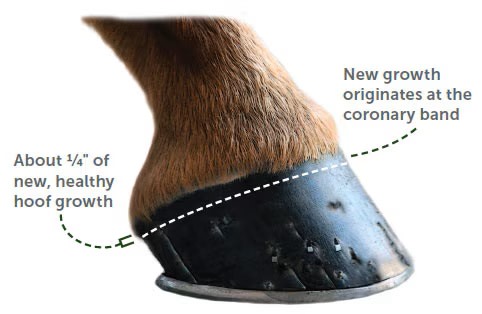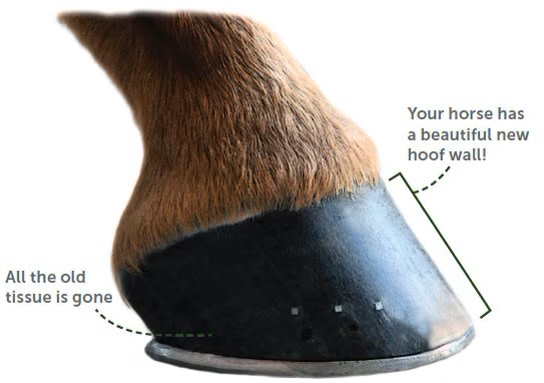
Seasonal Variation in Equine Hoof Growth and Implications for Traditional Six-Week Shoeing Cycles
Introduction
Hoof growth in horses is a dynamic process influenced by systemic metabolism, environmental conditions, and mechanical loading. Farriery has traditionally adhered to a six-week shoeing cycle, an interval widely accepted for maintaining hoof balance and preventing pathological distortion. However, emerging evidence suggests that this rigid cycle may not reflect the biological reality of seasonal growth variation, particularly under temperate conditions. A recent study by Thomason et al. (2024) highlighted measurable differences in hoof growth between summer and winter, raising important questions about the adequacy of a fixed cycle. This essay critically evaluates the metabolic and biomechanical drivers of seasonal hoof growth, considers the consequences for farriery practice, and outlines potential adaptive approaches to shoeing intervals.

Metabolic and Environmental Drivers of Seasonal Growth
Hoof horn production is a keratinisation process regulated by blood supply to the coronary corium, influenced by diet, endocrine status, and environmental conditions. Increased daylight length and higher ambient temperatures during spring and summer stimulate enhanced peripheral circulation and metabolic activity, promoting faster keratin synthesis (Pollitt, 2010). In contrast, colder winter conditions reduce peripheral perfusion, slowing horn production (Clayton & Hood, 2020). Nutritional influences are also significant, with pasture availability and higher non-structural carbohydrate intake during spring and summer acting as further stimulants to horn production (de Laat et al., 2019).
Biomechanical Consequences of Seasonal Growth Variation
Rapid hoof growth in summer can result in longer toe conformation and reduced dorsal hoof wall angle if the shoeing interval is not shortened accordingly. These changes alter the mechanical breakover point, increase strain on the deep digital flexor tendon, and elevate forces within the navicular apparatus (Eliashar et al., 2004). Conversely, in winter, slower growth may permit a longer cycle without compromising hoof balance. Rigid adherence to a six-week cycle therefore risks either permitting distortion during periods of rapid growth or unnecessary intervention when growth is slow.
Figure 1. Seasonal hoof growth rates in horses, showing increased horn production during spring and summer compared with reduced rates in winter and autumn.
Radiographic Evidence of Growth-Induced Imbalance
Radiographic evaluation demonstrates the geometric implications of seasonal growth. Excessive summer growth produces a long-toe, low-heel conformation, associated with increased dorsal wall length and reduced solar angle. This alters load distribution across the distal phalanx and increases the risk of pathology such as underrun heels and navicular stress.
Figure 2. Radiographic-style schematic comparing a balanced hoof (black outline) with one exhibiting excessive summer growth (red outline), demonstrating the effect of prolonged intervals on dorsal wall angle.
Towards Adaptive Shoeing Intervals
The data presented by Thomason et al. (2024) support a more flexible approach to farriery scheduling, tailoring shoeing cycles to seasonal growth rates rather than rigid six-week intervals. Shorter cycles of four to five weeks may be appropriate in summer, while cycles of seven to eight weeks may be acceptable during winter when growth is reduced. This adaptive model offers a proactive means of maintaining hoof balance and minimising biomechanical compromise.
Figure 3. Adaptive shoeing calendar based on seasonal hoof growth, showing shorter cycles during summer months (four to five weeks) and longer cycles in winter (six to seven weeks).
Conclusion
Seasonal variation in hoof growth challenges the universality of the six-week shoeing cycle. Horses in temperate climates exhibit accelerated horn production in summer, with associated risks of biomechanical imbalance if trimming and shoeing are not adjusted. Conversely, winter cycles may safely be extended. A seasonally adaptive approach to farriery, guided by both growth data and individual conformation, may offer the most effective strategy for optimising hoof health and performance.

References
Clayton, H. M., & Hood, D. M. (2020). The equine distal limb: Structure, function, and pathology. Equine Veterinary Journal, 52(4), 421-430.
de Laat, M. A., McGowan, C. M., & Sillence, M. N. (2019). The influence of nutrition and season on equine hoof growth. Veterinary Journal, 248, 65-72.
Eliashar, E., McGuigan, M. P., & Wilson, A. M. (2004). Relationship of foot conformation and force applied to the navicular bone of sound horses at the trot. Equine Veterinary Journal, 36(5), 431-435.
Pollitt, C. C. (2010). Equine laminitis: Current concepts. AAEP Proceedings, 56, 165-179.
Thomason, J. J., Winkler, B., & Lischer, C. J. (2024). Seasonal variation in equine hoof growth and implications for farriery practice.
